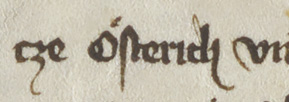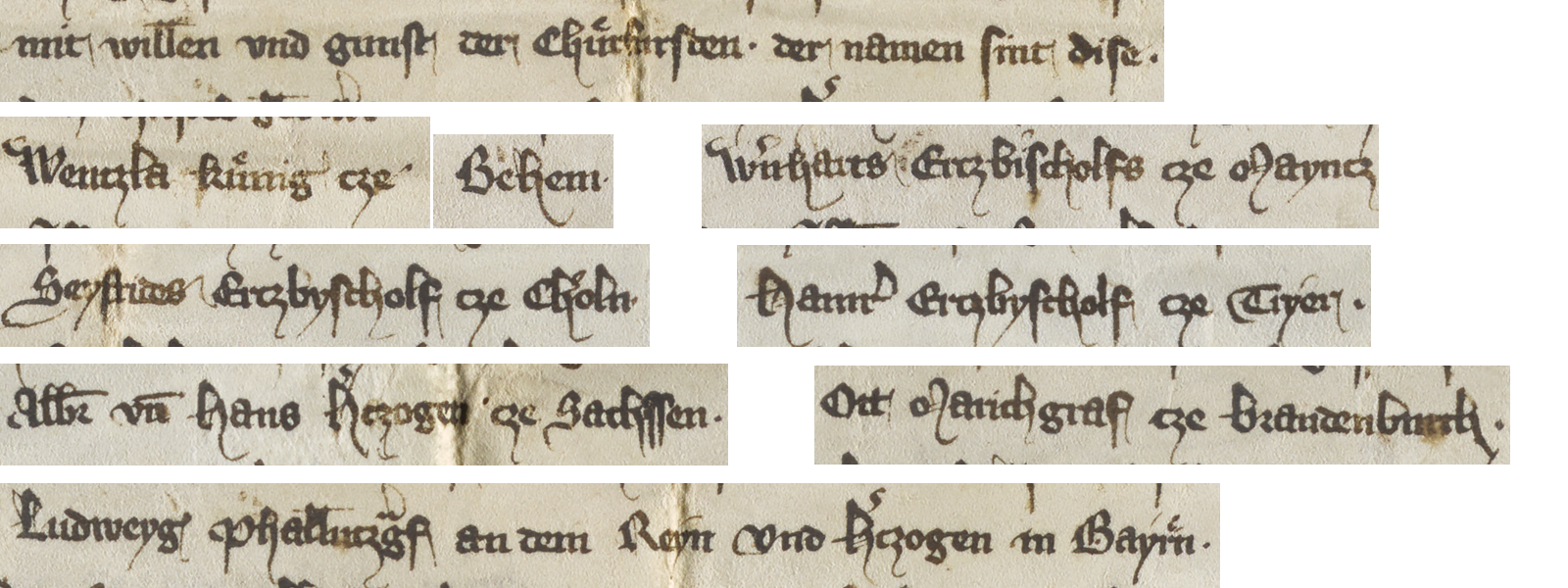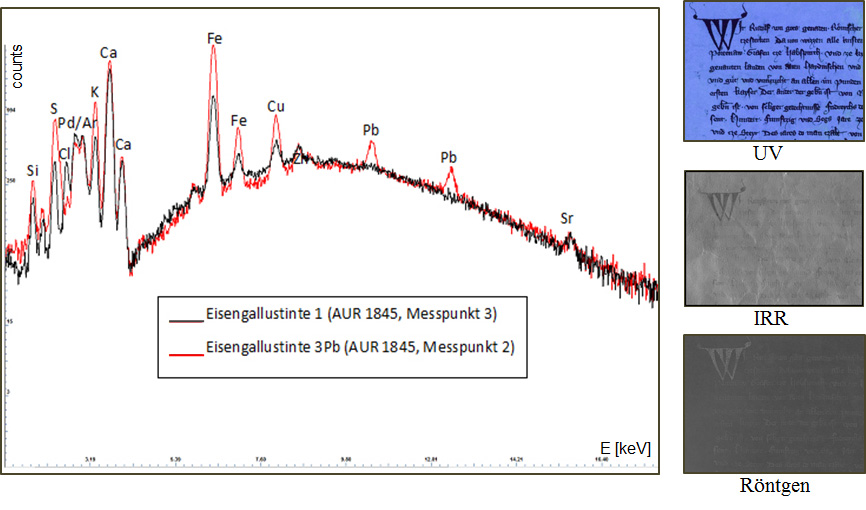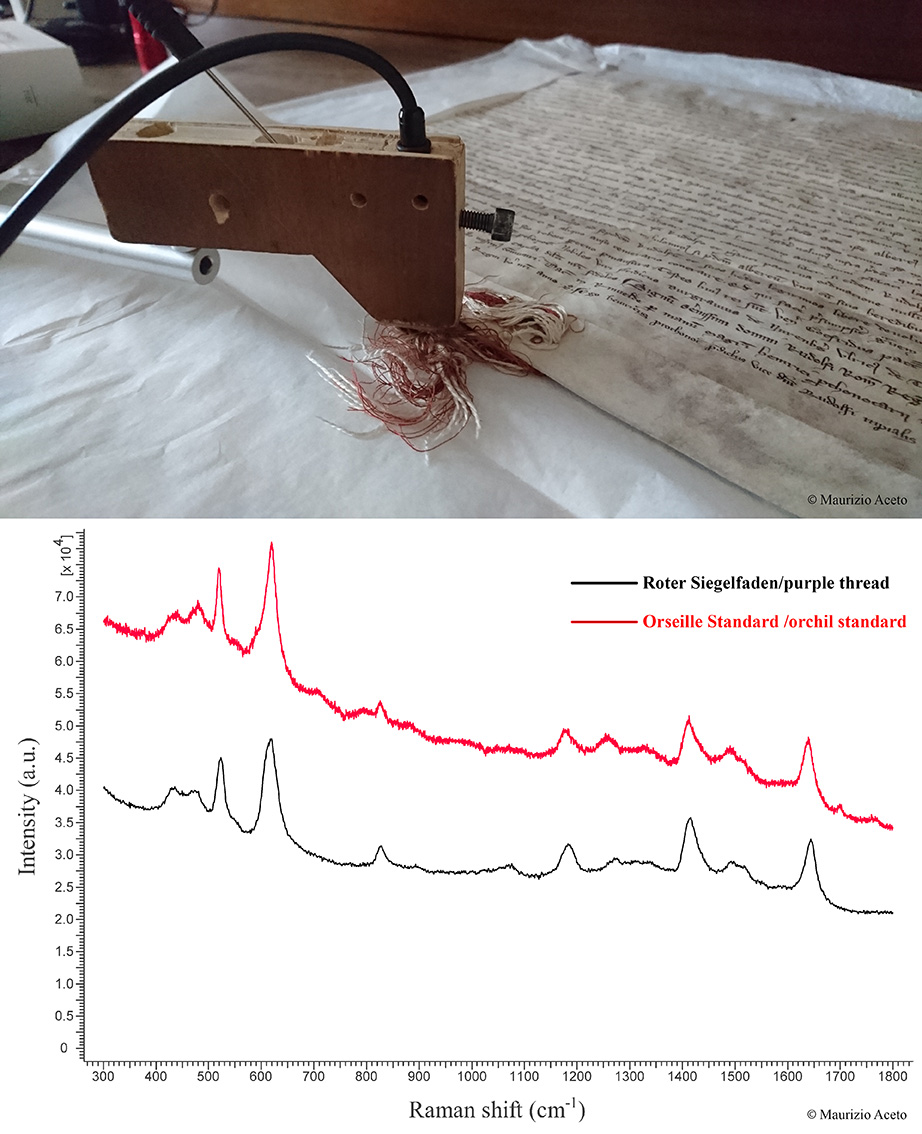


This document was purportedly issued by Rudolf I (1218–91), the first Habsburg to be king of the Holy Roman Empire. Rudolf was elected by the prince-electors in 1273. After Rudolf prevailed over his rival for the throne, the king of Bohemia, Ottokar II Přemysl, he was able to extend his dominion. The Habsburgs, whose origins were in Swabia, received the Austrian lands in 1282 as a fief in common for the dynasty. Two other Habsburgs were to occupy the throne of the Holy Roman Empire in the first half of the 14th century: Albert I (ruled 1298–1308) and Frederick the Fair (ruled 1314–30).

In the Early and High Middle Ages documents were invariably drafted in Latin. It was only in the second half of the 13th century that German language gradually came to be used. In the royal chancellery of the Holy Roman Empire, German was used more frequently beginning in the reign of the Habsburg Rudolf I (ruled 1273–91). The use of the vernacular does not make comprehension of medieval texts easier, however. Latin legal terminology was precisely defined, whilst German equivalents are often not as exact. Moreover, German orthography was not firmly established with the consequence that many alternate spellings for names and words were used.
One of the characteristics of the Holy Roman Empire was that it was an elective monarchy. The throne was not inherited within a single family. Instead, a new king was elected from among the princes of the empire. The group of princes entitled to act as electors was not definitively fixed until the Golden Bull was issued. Only from 1356 was the college composed of seven secular and spiritual prince-electors established: the king of Bohemia, duke of Saxony, count palatine of the Rhine, margrave of Brandenburg, and the archbishops of Mainz, Cologne, and Trier. Election was by a simple majority. The archbishop of Mainz, who held the office of arch-chancellor of the empire, cast the final, and in the event of a tie, deciding vote.


The usual iron gall ink with admixtures of carbon-based ink was used for the text. The initial “W” at the beginning is distinctive, however. It shows up clearly in most of the imaging techniques used. In the x-ray radiography image in addition to a greater absorption, clear particles of brighter appearance can be detected. The material analysis showed that for these initials iron gall ink with an admixture of lead containing material was used. This suggests that the initials were inserted into the document by a second scribe.

The seal that was originally affixed by the multi-coloured cords has not been preserved. Analysis of dyes used to colour the seal cords, undertaken by Maurizio Aceto (Università degli Studi del Piemonte Orientale, Alessandria, Italy), revealed that a vegetal dye derived from Reseda luteola (weld, dyer’s rocket) was used for the yellow, and orchil, a colouring extracted from lichens, for the red. A double dyeing with blue and yellow pigments produced the green; probably used in this process was indigo blue from the European woad and Reseda luteola for the yellow dye. All these dyes were in common use during the Middle Ages, mostly to colour textiles.

This purported document of King Rudolf of Habsburg (1218–91) is the only piece of the corpus of forgeries written in German. It is the first, which is addressed to the House of Habsburg. It thus does not extend the provisions of the deed of 1156, as do the other documents. Instead, this manuscript was intended to transfer rights and privileges originally granted to the Babenbergs to the Habsburgs as the new ruling dynasty. The Babenbergs died out in the male line in 1246 and were succeeded in Austria by the Bohemian king, Ottokar II (1233–78). Only after the battles of Dürnkrut and Jedenspeigen in 1278, at which Ottokar fell and King Rudolf I emerged victorious, did Habsburg rule in the Austrian lands begin.
Wir Rudolf von gots genaden Roemischer chunig, cze allen czeiten ein merer dez reiches, tuen kunt, daz wir haben angesechen und in unser chunichleich wierdikeit und lautterm gemuet gunstichlich betracht, mit wew wir mugen unser pluet lobleich erhoehen und sein er und recht cze sterken. Davon wizzen alle kristen des heyligen reichs und unser getrewn, baider gegenwurtigen und chunftigen, daz fuer uns komen di hochgeborn fusten [!] unser lieb suen Albrecht und Růdolf herczogen cze Oesterich und cze Steyr, herren cze Krayn, auf der Marich und cze Portenaw, grafen cze Habspurch und ze Kyburch und lantgrafen cze Elsazzen, und mit in die pesten ierr lande, der erschinen vor unser kuenichlichen hoech als liecht fakeln ierr lauttern trewn und paten uns dyemuetichleich, daz wir bestêtten geruechten die brief, die den vorgenanten landen von alten haydnischen und Christen kaysern und kuenigen von ierr grozzen guettet wegen gunstiklich geben wêrn, und daz wier in auch darueber gewunnen bestetigung der chuerfuersten, wan si nu new herren in denselben landen werne, wan diselben brief gancz und guet und unverrucht an allen iern punden und artikeln warn. Der erst brief gewen ist von sêliger gedechtnusse weilnt Hainreychs dez vierden Roemischen chuniges, kayser Haynreichs sun, da im bestett sint czwen haydnisch brief, ainer der gewen ist von Julio dem ersten kayser, der ander der geben ist von Nerone dem durhæchtunden kayser, und derselb kuenich Hainreichs brief geben ist Ernsten margrafen cze Oesterreich des jares, do man czalt von gotes gepuert tausent fumphczig und acht jar, cze Durrenpuch. Der ander brief geben ist von seliger gedechtnusse Fridreychs des ersten Romischen kaysers, damit er daz lant cze Oester(reich) czu einem herzogentuem gemacht hat, und der geben ist dem grozzen fuersten Haynreichen, dem ersten herczogen cze Oester(reich), des jars, do man czalt von gotes gepurd tausent hundert fumfczig und segs jare, ze Regenspurch. Der dritte brief geben ist von Hainr(eich) seligen gedechtnusse weilnt Roemischen kuenigs, der auch bestêtt alle freyung des egenanten landes cze Oester(reich), der gewen ist dem frumen Leupolten herczog cze Oesterreich und cze Steyr des jares, do man czalt von gotes geburt tausend czwayhundert acht und czwainczig jar, cze Ezzlingen. Der vierd brief geben ist von seliger gedechtnusse Fridreychs des andern Roemischen kaysers, cze Jerusalem und Sicilii kuenig, damit er bestêtt alle di freyung der egenanten lande cze Oester(reich) und cze Steyr, der geben ist dem forichtsamen fuersten Fridreichen herczog cze Oster(reich) und ze Steyr und herre cze Chrayn, an demselben brief wir cze czeug(en) gesten, dieweil wier graf gewesen sein, der geben ist nach Christes geburt tausend czwayhundert und vierczig jar ze Pern.
Daz haben wir getan und haben bestetigt und vesten auch alle die brief, freyung und genade, die in denselben briefen begriffen sint, mit willen und gunst der chuerfursten, der namen sint diese: Wenczla kuenig cze Behem, Wernharts erczbischolfs cze Mayncz, Seyfrides erczbyscholf cze Choeln, Hainr(ich) erczbyscholf cze Tryer, Albr(echt) und Hans herczogen cze Sachssen, Ott marichgraf cze Brandenburch, Ludweyg phallenczgraf an dem Reyn und herczogen in Bayrne, also daz di vorgenanten fursten Albr(echt) und Ruedolf herczogen, unser lieb sune, und ier erben und nachkomen an denselben landen alle die recht, freyung und genad haben schullen, als ob si in selb(en) gegeben wêren, in allen den landen, die si yeczunt habent oder hienach gewinnent. Ez schol auch den vorgenanten unsern sunen und ir erben und nachkomen und iern landen dhainen schaden bringen, ob der vargenanten brief dhainer oder yeder artikel besunderleich verruchkt oder czeprochen wer von wegen Otakchers chunigs ze Peheym oder Bela kuenigs cze Ungern oder von nyeman andern oder noch czeprochen moecht werden, wand si die egenanten lant cze unrecht und in raubes weyse inne gehabt habent, sunder si schullen alle und yegleich recht, freyung und gewonhait haben in aller der mazze, als die obgenanten brief lautent.
Geben cze Reinueld durich hant maister Hainreichs, unsers obristen schreiber, des moeneydes Junii des aindleften tages nach Christes geburt tausent jar czwayhundert jar und in dem drey und achczigisten jar, unsers reichs in dem czechenten jar.
King Rudolf I of the House of Habsburg together with the prince-electors confirms to his sons Albrecht and Rudolf of Austria and Styria the enumerated privileges of heathen and Christian emperors and kings.
purportedly Rheinfelden, 11 June 1283 (forgery 1358/59)
Parchment, seal missing, dark red, yellow and green silk cords
Vienna, Austrian State Archives, Haus-, Hof- und Staatsarchiv, AUR 1845
The use of ultraviolet (UV) light induces some materials, including many organic media, to manifest a differently coloured and characteristic fluorescence. UV radiation may also be completely obliterated by absorption. This may provide preliminary information about materials and divergent compositions of material. Indications of changes and the condition of object surfaces, for example, subsequent alterations and damage, often show up more clearly in photographic images taken under ultraviolet light.
Along the upper and lower margins traces of previous mounting may be found: residue of adhesive tape on the upper edge as well as several thumbtack marks on both edges. Residue of the adhesive has bled through from the verso of the document.
The technique of infrared reflectography (IRR) allows a more profound insight into the structure of objects. For the study of documents in particular IRR allows conclusions to be drawn about the inks used. The two most commonly employed types of ink, iron gall and carbon-based (soot) ink, differ clearly when exposed to infrared radiation.
Distinct surface structures such as differing roughness of various areas of the skin, creases of the original folding, as well as quite pronounced folds and wrinkles on the parchment are visible by IRR.
Iron gall ink with an addition of carbon-based ink was used as the writing medium. This can be seen applying IRR and is reflected clearly on the x-ray radiographic image.
When X-rays penetrate objects they are absorbed differently depending on the object’s thickness and the presence of heavy elements before being projected onto x-ray sensitive film.
For this document only a small part of a calf’s skin was used, hence no anatomical details are visible on the x-ray radiographic image. In the centre of the upper portion of the parchment the x-ray radiographic image reveals a somewhat larger defect. A number of smaller defects are to be found in the same area and around the folds.